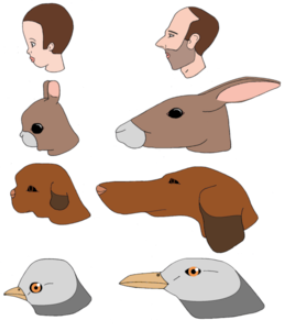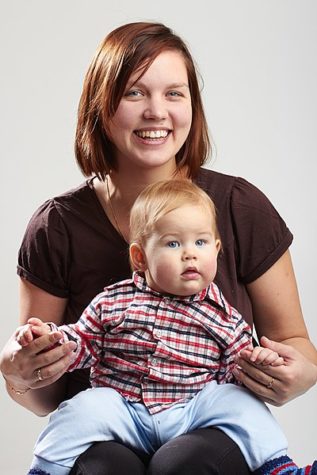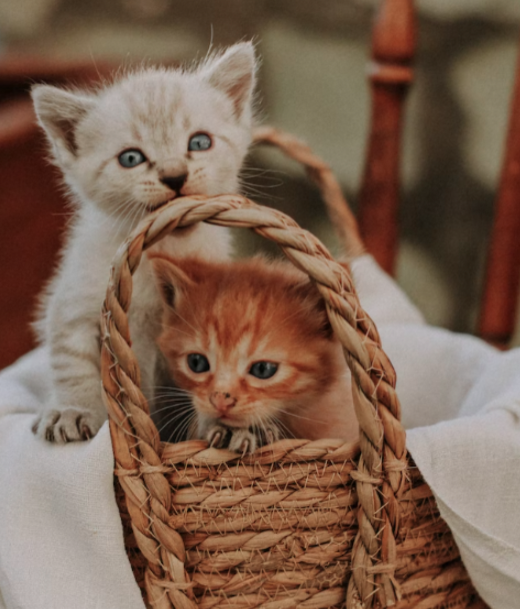Cuteness Overload: The Neurology and Psychology Behind ‘Cute Things’
The feeling of intense euphoria after seeing cute things is not an isolated incidence.
Kittens trigger serotonin and dopamine in people’s brains, making them more loveable to people.
The simple phrase of “awh” can’t help but escape your lips when you see big brown eyes and a delicate button nose. Yep, that’s right, a dog. A man’s best friend has all the qualities of a cute thing: round eyes, a round head, and a small nose. In fact, these are some of the significant aspects that draw people to adore them. “I think the rounder eyes, rounder head, and short/small noses make us perceive the pictures on the left as cuter,” said Louisiana Stahl ’23.

According to Merriam-Webster, the term cute is defined as attractive in a childish, youthful, or delicate way. And that is why almost all students polled chose the younger, or more childish, depiction of the thing being presented. In fact, 65 percent of students polled said that they found kittens cute because they look innocent, have big eyes, and have a chubbier profile than mature cats. Babies have softer skin that seems more pinchable, inviting people to want to be closer to them…if only to pinch their cheeks. “The baby has chubby cheeks. I am a sucker for pinchable baby cheeks,” said Yaniyah Felder ’25. These delicate features continue to draw humans closer to love cute things.
Picture yourself in front of a one-month-old puppy. No, you’re not the only one that feels suddenly very happy, or in love, upon seeing cute things. It is a perfectly normal response to the overwhelming amount of dopamine being released into your brain. All of a sudden, you are flooded with stress-relieving hormones and you instantly feel happier. As depicted by many cute and small things make you feel happy, and sometimes, with the addition of oxytocin, you may just fall in love.
With such defining qualities that we see on a near-daily basis, is there really an effect on you from seeing cute things? Considering seeing cute things is inexplicably linked to snap-fire activity in the orbitofrontal cortex, the main part of the brain involved in emotions and memory, there does seem to be an evident connection. As people, we have linked activity in that region to an appreciation of beauty. From the University of Oxford, scientists have discovered that since the orbitofrontal cortex is linked to pleasure, we are able to react quicker to anything cute.
We grow up as cute and treasured, so, naturally, cute things invoke the same memories of what happened to us when we were “cute.” When we were 2 or 3 years old, we felt safe and comfortable doing a particular activity, or just in general, because of love and affection. As such, we associate that activity with comfort, and it leads us to want to replicate that emotion for others, since you had a good and strong emotion tied to it. When I was younger, I used to love piggybacking on my cousin’s back, because, like most completely naïve children, I thought it was fun and that it was safe for me. Even now, whenever I see toddlers piggybacking, I can’t help but fawn over how cute they are, as I still remember what I used to do.
As humans, we have the instinct to want to protect anything cute due to the influx of dopamine. Through hundreds of years of cultivating cats, dogs, cows, deer, and the human race as a whole, humans have shown that cute things always remain victorious. Even frogs are characterized as cute, by some, and as such are sometimes the first thing that pop up when we type ‘cute things’ into a Google search.
Babies are not easy to take care of, but they are cute, so it is worth it, just to see the giggles of the baby. “Babies have tinier and cuter features that invoke human’s instinct to protect,” said Grace Lin ’23. The designation of the word “cute” is not restricted to just babies, but anything with those features whether it is cats, rabbits, or kawaii images (‘kawaii’ is the culture of cuteness in Japan). We see such things as vulnerable and thus, we protect them, ensuring their survival and the survival of the species they belong to. That continuous loop creates more and more cute things.

When comparing an image of a baby and a grown women, 90% of students polled said that they found the baby more cute. The reason why there is such a huge range is because babies have that special quality around them. “The baby looks innocent, and he has chubby cheeks,” said Vicky Lin ’25. Lin echoes many opinions of other students: when something looks wholesome and possesses the qualities of a cute thing, it is considered cuter than something that has more mature features. This baby was compared to a woman who was described as looking more mature. When juxtaposing the two people, most chose the baby.
Cuteness doesn’t just have to encapsulate objects, but can also refer to actions. Though the definition is not the same as with things, actions still carry a sense of cuteness. Such actions are often named endearing. Endearing is similarly related to doing something that is seen as lovely or affectionate in a childlike way. It is something that you might say when a girl does something nice for a guy. It is something that might be said then you give off a bubbly personality. When someone is called endearing, they may feel warm and fuzzy inside. Such feelings often follow someone first believing the actions are cute. Much akin to opening up a box of kittens with their big blue eyes staring back at you, actions can incite those feelings in others. If we use the definition of cute that Webster provides, then though those actions will be seen as childish, they will come off as playful and cute.
The impact of seeing adorable things lingers long after the person sees the image or encounters the cute action. After seeing images of cute things, 48 percent of Bronx Science students surveyed said that a lingering effect after seeing sweet things was that they were more careful and more focused. However, almost everyone said that they felt happier and some were even a little bit more distracted, wanting more of the things that they saw before: images of dogs, cats, and babies. For actions, the same feeling carries over. “I feel happy and energetic for 30 minutes to an hour after I do playful things with friends,” said Katrina Tablang ’23.
So whether it is cute actions, cute things, or just the simple glance at a cute poster on the wall, our brains do a lot more than we think. From the sudden serotonin and dopamine release to the need to protect things, you are not the only one that feels it. We’ve all had that feeling at one time or another, and there is no need to be scared to share these images with others, as they might just feel the same way.
With such defining qualities that we see on a near-daily basis, is there really an effect on you from seeing cute things? Considering seeing cute things is inexplicably linked to snap-fire activity in the orbitofrontal cortex, the main part of the brain involved in emotions and memory, there does seem to be an evident connection.
Camille Chen is the Managing Editor for ‘The Observatory’ yearbook and a Staff Reporter for 'The Science Survey.' Camille likes spotlighting the multitude...

